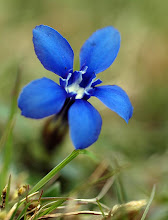Hard to believe, maybe, but inside a horse chestnut Aesculus hippocastanum bud like this there’s a whole year’s future growth, folded, packaged and ready to be unpacked at the first hint of spring......
A vertical slice through the bud reveals next year's spike of flowers inside, preformed, packed in mass of white hairs (the bud's equivalent of loft insulation), surrounded by an armour of overlapping bud scales and sealed in resin, protected against the rigours of the coming winter.......
Cranking up the magification a little more reveals the sectioned individual flowers. The pink lines around the buds are the sepals and petals, and the elongated yellowish objects inside are the stamens that will produce the pollen that next year's bumblebees will collect...
A transverse section across the flower bud reveals the individual flower buds (surrounded in pink) and next year's leaf stalks (the ring of green circles around the outside of the bud, just inside the overlapping, interlocking bud scales)....
... and at higher magnification in this transverse section you can see the pink sepals and petals of the flower buds a little more clearly. That convoluted wavy green line between the flower bud and the bud scale is the blade of one of next year's leaflets, tightly folded at this stage. The mass of white insulating hairs inside the bud coat the new leaflets when they emerge from the bud in spring, looking in their earliest stages like little furry fists. Something to look forward to.
For a reminder of what those microscopic flower buds will become, hop over to http://cabinetofcuriosities-greenfingers.blogspot.com/2009/05/horse-chestnut-traffic-signals.html
... and if you want to look even further forward, to next autumn, and see what they'll produce, take a look at http://cabinetofcuriosities-greenfingers.blogspot.com/2009/10/alien-that-conquered-britain.html
... and for a look at some other buds from different tree species, hop across to http://cabinetofcuriosities-greenfingers.blogspot.com/2009/11/tree-spotters-guide-to-buds-part-1.html


































